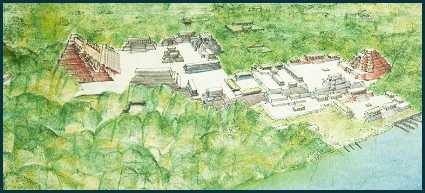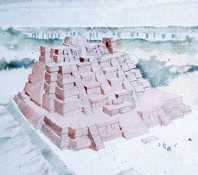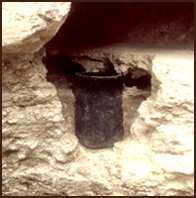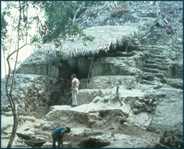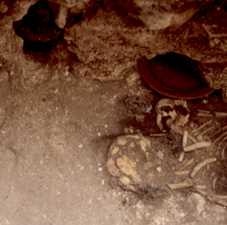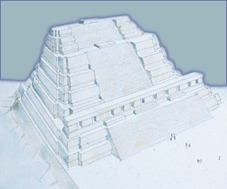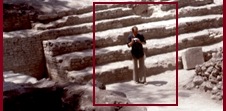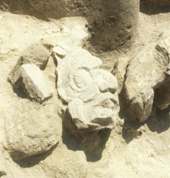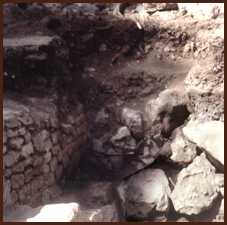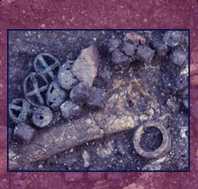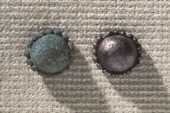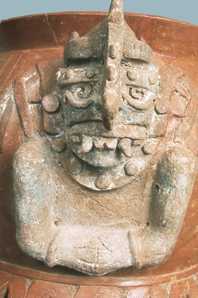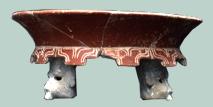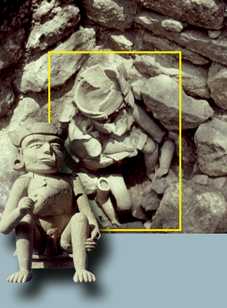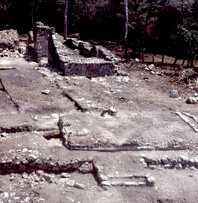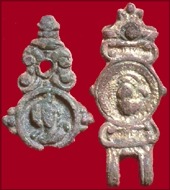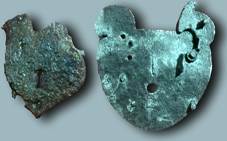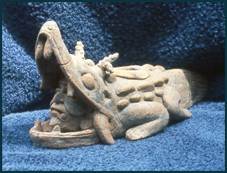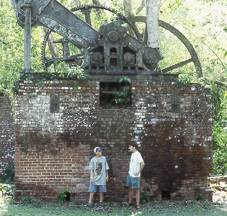As is always true of a large
and long-lived community, the beginnings of Lamanai's 3200-year
occupation history lie hidden beneath the accumulation of the
centuries. Judging by a radiocarbon date associated with abnormally
high concentrations of corn pollen in a feature called The Harbour,
the Maya had established an agriculturally based settlement at
Lamanai by or before 1500 B.C. The concentration of pollen suggests
very strongly that the material represents waterborne ceremonial
activity in what was, probably throughout the site's occupation,
a small arm of the great lagoon on which Lamanai faces. This
in turn suggests that the settlement may have been of moderate
size by 1500 B.C. There is a very small ceramic sample that is
only a few centuries later in date, but the earliest extensive
evidence, including both residential and communal structures,
falls around 500-700 B.C., and reveals Lamanai as a nucleated
community with a somewhat diffuse Central Precinct. By this time
or slightly later, residential settlement had embraced what was
to become the heart of the Classic-period Central Precinct, the
area of Structure N10-43.
Near the end of the Preclassic,
probably around 100 B.C., a major transformation of the site
took place. Whereas the community's centre lay originally in
the northernmost part of the site as we see it now, probably
to be near the small area of raised fields north of the site's
margin, its late Preclassic heart shifted southward. The shift
embodied one of a series of truly major changes in Lamanai's
appearance as well as its activity patterns. In a real "urban
renewal" project, a group of small southern residential
structures was supplanted by the massive initial stage of Structure
N10-43, which served as the focal point for the first major plaza
group to appear at the site.
The pattern of a single dominant
temple flanked and faced by markedly smaller buildings came to
be characteristic of Lamanai's Classic development, and may in
some senses have persisted throughout the remainder of the site's
occupation. As was also the case with earlier Preclassic structures,
N10-43 saw some measure of the dedicatory cache deposition that
was characteristic of most Maya construction. However, as remained
true for the full course of the site's history, the number and
splendour of the caches was limited in comparison with sites
such as Altun Ha, some 40 km to the east. At about the same time
as the building of N10-43's first stage, a complex three-structure
group atop a platform, probably set in turn on a larger platform,
came into being as the start of what ultimately grew into the
N9-56 group.
N10-43 continued as a principal
element during the Early Classic, and during this time the multi-structure
N9-56 group began to take the shape that it was to retain throughout
the Classic. In contrast with the relative poverty of dedicatory
material in both settings, N9-56 and its supporting platform
became the sites of two comparatively rich tombs of a construction
type unknown elsewhere in the Maya world. Beneath complex hoopwork
domes, which were covered in coarse textiles that were in turn
swathed in fine textiles soaked in red pigment, the occupants
of the two tombs lay surrounded by wooden objects, pottery vessels,
and a variety of jade and shell mosaic ear ornaments and apparent
pendants, among other artifacts. Luckily the vessels fix the
dates of the two tombs near the beginning of the sixth century
A.D., but unluckily neither ceramic nor other evidence tells
us which tomb preceded which. The issue is particularly important
because the occupant of Tomb N9-56/1 is male and the individual
in Tomb N9-53/1, seen at the left, is female.
The closeness of the two interments
in time as well as space indicates very strongly that one individual
succeeded the other as Lamanai's ruler. The old, male chauvinistic
view would have been that the male was the true ruler, and on
his death his wife succeeded him. Today we can recognize three
other possibilities: the female was the true ruler, and upon
her death her consort succeeded her; the two were brother and
sister; or one was the parent of the other. The last is the least
likely, because the two interments are close in date and both
individuals are unquestionably adults.
The most interesting aspect
of the two tombs, besides the fact that N9-53/1 documents female
rulership at Lamanai, is the difference in their location. Tomb
N9-56/1 lay in the heart of the temple, on its midline, a highly
honorific position. Tomb N9-53/1, in contrast, lay in a pit dug
into bedrock and covered by an element of the front of the large
platform on which N9-56 sits. Both its association with a subsidiary
platform rather than the principal temple and its position far
from the platform's midline make the tomb appear less important,
but form and contents convey the opposite message.
At about the same time as
the construction of the two tombs, or perhaps slightly earlier,
came the beginning of the southernmost plaza group in the Central
Precinct, dominated by Structure N10-9. This plaza and the assemblage
of buildings raised on a high platform at its northern border,
a group known today as "Ottawa," appear to have become
the main focus of Lamanai public life during the Late Classic.
In its original form the group consisted of two plazas at different
levels, bordered by residences and buildings that probably saw
combined residential and administrative use.
By this time a distinctive
form of construction known as the Lamanai Temple Type had come
into being. The type is characterized by the absence of a chambered
building at the platform top and the presence of a long, narrow
chambered unit set athwart the central stair, usually about one-third
of the distance from the platform's base to its top. The Lamanai Temple Type is exemplified
by the middle construction stages of N10-9, as well as by Late
Classic modifications to N10-43, to other buildings in the N10-43
plaza group, and in some measure by changes to N9-56. More than
the ceramics or other artifacts from the site, the distinctive
temple type serves to identify links with other centres in the
area; a single example, Structure B-4/7, is known at Altun Ha,
and one is reported also from Chau Hiix, which lies almost exactly
halfway between Altun Ha and Lamanai.
Among the site's many significant
features, perhaps the most important is Lamanai's history as
the Classic came to an end. Whereas neighbouring sites proceeded
through a period of decay to final collapse of sociopolitical
structures in the ninth and tenth centuries, Lamanai survived
this time of upheaval, and lived on into the Postclassic. There
is, in fact, very good evidence that the people of Lamanai exerted
one of their greater efforts in construction in the eleventh
century, with a huge transformation of the "Ottawa"
group that occupied several centuries and may have involved the
amassing of more than 20,000 metric tonnes of building material.
By this time modification and maintenance, and probably the use,
of most or all of the buildings in the northern part of the Central
Precinct had ceased, and some buildings may already have begun
to disintegrate.
By the end of the Terminal
Classic the focus of life at Lamanai had shifted very strongly
southward, and by or before A.D. 1100 a revamped area east of
N10-9 had been combined with the drastically modified "Ottawa"
group to make up a new, reduced Central Precinct. Whether population
had declined by the twelfth century is not clear, but it is abundantly
clear from the archaeological evidence that the restructured
community continued to thrive, and began to enjoy interchange
with sites in the northern part of the Yucatan Peninsula.
By A.D. 1200 if not earlier,
copper-tin bronze objects, primarily bells and clothing ornaments,
had begun to flow into Lamanai from sources in west Mexico, the
Oaxaca Valley, and probably middle Central America. Out from
Lamanai to northern Yucatecan centres went a distinctive style
of ceramics, and probably other goods and ideas as well. The
ceramics, defined at Lamanai as the Buk Phase, are marked by
extensive incised decoration, usually highlighted in black against
the red to red-orange body colour. In addition to a great variety
of tripod and some tetrapod forms, Buk vessels include complex
censers and vessels of unknown, provbably ceremonial, use, to
which we have given the name "chalices."
In the chaos that surrounded
Lamanai from about A.D. 875 onward, the centuries of the Early
Postclassic are quite likely to have been a time in which the
community saw immigration of people from the fringes of nearby
centres that were undergoing gradual abandonment. Unfortunately
but quite expectably, the archaeological evidence does not show
how the inhabitants of Lamanai dealt with a surrounding Southern
Lowlands world on which the aftermath of the Classic collapse
continued to tighten its grip.
The picture of Lamanai in
the Terminal Classic and Early Postclassic seemed at first to
be of an island of relative calm in a sea of chaos. Beginning
in 1986, however, our work at the site of Marco Gonzalez on Ambergris
Caye, about 75 km northeast of Lamanai, has shown that in these
same centuries at least one other settlement continued to burgeon.
The island community's prosperity during the Postclassic appears
to have stemmed at least in part from close links with Lamanai,
which are documented by the presence of masses of Buk-Phase pottery,
much of it with distinctive proportions and decoration that indicate
manufacture elsewhere than at Lamanai, probably on the island
itself. Marco Gonzalez may, in fact, have reached its zenith
between about A.D. 1150 and 1300, a period that also saw a high
level of prosperity and vibrance at Lamanai.
Later in the Postclassic Lamanai
appears to have shrunk even further into its southern focal area,
but material-culture innovations continued, especially in ceramics,
as presumably did trade with centres farther to the north. Throughout
the centuries of the Postclassic Lamanai's inhabitants not only
continued modification and maintenance of the front of the southernmost
Classic temple, Structure N10-9, but also retained an attitude
of reverence towards decaying structures farther north. By about
A.D. 1300 or a bit earlier the residents of Lamanai had begun
to make offerings in the ruins of northern Central Precinct buildings,
usually by burying vessels in collapse debris, on or near the
primary axis. Between A.D. 1400 and 1450 they undertook one of
the larger ritual offerings in the community's history in just
such a decaying temple setting, surely a sign that the ancient
scenes of religious activity were still seen as places of great
power. Atop Structure N9-56 Lamanai's people smashed and scattered
a huge quantity of figural censers, probably both locally made
and imported. The number of vessels, perhaps as many as 100,
and the symbolic content of the objects combine to bespeak the
truly major importance of the event. Near the time of the great
offering, but whether before or after it we cannot say, the Maya
removed a carved stela from some other location and re-erected
it in front of N9-56. Together with this effort came the construction
of a group of very small platforms at the foot of N9-56, and
the tiny buildings also served as sites for offerings that included
miniature human or deity-figure vessels. In this same period
construction was proceeding in the Postclassic Central Precinct,
and probably in scattered locations elsewhere around the site
as well.
As the Postclassic neared
its end the citizens of Lamanai imported ceramics from the Tulum
region in what is now Quintana Roo, and appear to have been receiving
objects from central or southern Mexico as well. The community
was quite clearly still a vibrant one throughout the prehistoric
period, for around the turn of the sixteenth century its people
developed a new style of ceramics, which we term the Yglesias
Phase. At about the same time Lamanai's inhabitants took a significant
technological step forward by beginning to work metal. Previously
unknown in the Maya area, the casting of bronze objects became
part of Lamanai's cultural array with the production of bells,
rings, needles, axes, and other forms. Analysis of the objects
shows that the metal used in their manufacture was produced by
the melting down of artifacts, almost certainly part of the inventory
imported in earlier centuries. The community's strength is reflected
by the early sixteenth century burial of an individual who may
have been the last prehistoric community leader; the interment
was attended with the same level of richness that had marked
the interments of his mid-Classic predecessors.
The Spaniards first set foot
on Lamanai's shore about 1544. In the succeeding century a zone
well south of N10-9, which had been transformed into the community's
heart by or before 1500, felt the winds of change once more as
the European presence inserted Christian churches and related
structures into the indigenous settlement pattern. As in many
other places, the Spaniards supplanted what was probably the
principal ceremonial building of immediate pre-Contact times
with a Christian church that closely resembled the one known
at Tipu. In the course of the demolition and new construction,
one of the Mayas apparently sought to copper his bets with the
ancient gods by placing a small animal-effigy vessel offering
in the remains of the soon-to-be-concealed Maya temple. Such
conjoining of the two religions presumably characterized Lamanai
from this point onward. Later, perhaps near 1600, the first church
was supplanted by a much larger and more permanent structure,
erected immediately to the north. The larger church suggests
ambitious Spanish plans for Lamanai, which appear never to have
been realized.
For nearly a century the Spaniards
held sway over Lamanai despite the fact that their presence there
was only intermittent. Christian worship was led by a visita
(circuit-riding) Spanish priest whenever he could be present,
but otherwise was probably presided over by a native sacristan.
A cacique, (native leader), whose home we believe we discovered
during excavation, was probably the lone voice of Spanish secular
control whenever no Spaniard was at the site. In his home the
cacique held numerous European utilitarian objects, ranging from
a steel axe and two knives to a variety of other pieces of metalwork,
which were symbols of his status as much as they were useful
tools. In addition, he possessed or served as custodian of two
books, of which the only evidence we recovered consists of two
portions of gilt bronze hinges.
In the 1630s rebellion broke
out among the southern lowlands Maya, and when Fathers Bartolome
de Fuensalida and Juan de Orbita arrived at Lamanai on their
way to Tipu in 1641 they found the second church and its outbuildings
burnt, and the people supposedly decamped to join the rebels
centred at Tipu. Though
the Spanish perception was that Lamanai lay abandoned, in fact
the Maya returned to occupy the Contact-period centre, including
the area of the churches, for what may have been more than a
century. As at Tipu, they continued to show reverence for the
second church as sacred space, and erected both a stela and a
small platform in what had been the church's nave. Here and elsewhere
in the Historic-period community the people deposited offerings,
as had been their custom from time immemorial. One of the offerings
in the church nave consisted of a group of miniature human-head
vessels, probably incense-burners, and another was a large bicephalic
crocodilian effigy. Together with other crocodile images with
highly unusual anatomical features, the church offerings document
a resurgence of Maya iconography, which in fact had probably
never been fully suppressed in the time of Spanish contact.
At a later time, probably
when ceremonial activity in the church zone had come to an end,
a Maya family moved into the sanctuary of the second church,
and for a considerable time deposited garbage around the building's
perimeter. At some point thereafter, perhaps early in the eighteenth
century, identifiable Maya presence at Lamanai came to an end,
though of course we cannot be sure that no families remained
scattered within what had been so great a centre for so long
a time.
After a break of a century
or more came the final chapter in the site's history prior to
commencement of the Royal Ontario Museum's excavations, a British
attempt at sugar production from about the 1850s to the early
1880s. The start of our work in 1974 marked the emergence of
Lamanai as a site for which we can now trace the outlines of
a Maya history thatt stretches from 1500 B.C. or earlier to perhaps
A.D. 1700 or later, the longest known unbroken span of occupation
in the Maya world.
